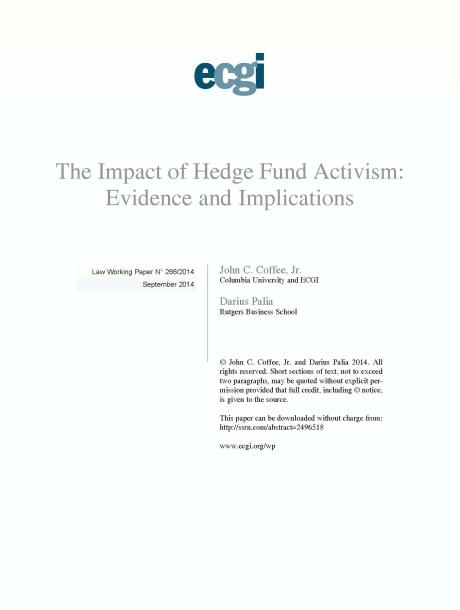
The Impact of Hedge Fund Activism: Evidence and Implications
Abstract
Hedge fund activism has increased almost hyperbolically. Some view this optimistically as a means for bridging the separation of ownership and control; others are more pessimistic, seeing mainly wealth transfers from bondholders or speculative expectations of a takeover as fueling the spike. Equivalent division exists over the impact of this increased activism, with optimists seeing real gains that do not erode over time and improvements in operating performance, and pessimists predicting shortened investment horizons, increased leverage, and reduced investment in research and development. Our perspective is analytic. We begin by surveying the regulatory and institutional developments that have reduced the costs and increased the expected payoff from activism for hedge funds. Here, we focus particularly on the formation of ?wolf packs??namely, loose knit associations of hedge funds that are formed prior to, or contemporaneously with, the filing of a Schedule 13D. We then look at other new institutional structures that are appearing, as typified by the alliance between Pershing Square Capital Management and Valeant Pharmaceuticals in their bid for Allergan. Then, we survey the empirical evidence on the impact of activism, looking successively at (1) who are the targets of activism?; (2) does hedge fund activism create real value?; (3) what are the sources of gains from activism?; and (4) do the targets of activism experience post-intervention changes in real variables? Although confident claims have been made by some researchers, we find the evidence decidedly mixed on most questions (other than the short term stock price impact). In particular, we find the conclusions about improvements in target operating performance that have been expressed by some to be overextended beyond their actual data and premature. Finally, we examine the policy levers that could encourage or chill hedge fund activism and consider the feasibility of reforms. The gains from hedge fund activism may be high both because such activity is relatively low risk (if asymmetric information can be exploited that is acquired before the filing of a Schedule 13D) and short-term (with the median hedge fund activist holding for approximately nine months). Still, we predict that the impact of most regulatory changes are likely to be marginal. Conversely, we believe that private
ordering (through techniques such as a ?window-closing? poison pill) could achieve at
least as much as regulatory changes.








